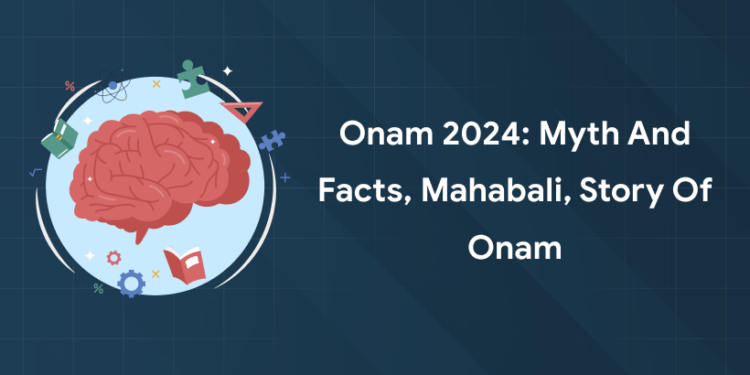Table of Contents
Onam is a major annual festival celebrated primarily in the Indian state of Kerala, marking the homecoming of King Mahabali. It usually takes place in late August or early September, depending on the lunar calendar. For 2024, Onam will be celebrated from September 5 to September 15. The festival is deeply rooted in both mythology and tradition, blending cultural celebrations with historical significance. Here’s a look at the myths, facts, and the story surrounding Onam.
About Onam Festival 2024
Onam is a vibrant and culturally rich festival celebrated predominantly in the Indian state of Kerala, marking the harvest season and honoring the mythical King Mahabali. Held annually in August or September, Onam spans ten days and features a blend of traditional activities, including Pookalam, Onasadya and many more. The festival fosters a sense of unity and joy, with communities coming together to celebrate Kerala’s heritage through music, dance, and games. It symbolizes the spirit of abundance, prosperity, and the enduring legacy of Mahabali’s golden reign.
The Mythology Behind Onam
1: Who was the first woman President of India?
Onam is deeply rooted in the ancient mythology of Kerala and is centered around the legendary figure of King Mahabali. The festival is not just a celebration of the harvest but also a tribute to a king who was revered for his just and benevolent rule. The mythological narrative of Onam involves several key elements:
1. King Mahabali’s Reign: King Mahabali, often referred to as Mahabali or Maveli, was a mighty Asura (demon) king who ruled over Kerala with unparalleled fairness and prosperity. Under his rule, the land flourished, and people of all castes and creeds lived in harmony. Mahabali’s reign was marked by his deep commitment to justice, equality, and the welfare of his subjects. His popularity and the golden age of his kingdom became a source of concern for the gods, who felt threatened by his growing influence.
2. The Intervention of Lord Vishnu: To restore cosmic balance, the gods sought the help of Lord Vishnu, who is known as the protector and preserver of the universe. Vishnu took on the guise of Vamana, a dwarf Brahmin, to approach King Mahabali during a grand yajna (sacrifice). Vamana requested just three paces of land from the king. Mahabali, known for his generosity, agreed to grant this modest request.
3. Vamana’s Divine Act: Once the request was granted, Vamana transformed into a gigantic form. With his first step, he covered the entire earth, and with his second, he covered the heavens. There was no space left for the third step, so Mahabali offered his own head. Vishnu, pleased by Mahabali’s humility and devotion, placed his third step on the king’s head, pushing him to the netherworld (Patalam).
Despite his banishment, Mahabali was granted a boon by Vishnu to visit his kingdom and people once a year. This annual visit is celebrated as Onam, symbolizing Mahabali’s enduring connection with his subjects and his legacy of equality and benevolence.
Free UPSKILLING Courses!
Take your first step toward mastering in-demand skills, acing interviews, and securing top-tier jobs with Entri's free upskilling courses.
Start Learning!The Significance of Mahabali
King Mahabali is a central figure in the Onam festival, symbolizing the ideals of justice, generosity, and unity. His legendary visit during Onam is seen as a time of renewal and a reminder of the values he upheld. Mahabali’s story is celebrated with joy and reverence, and his return is marked by various customs and traditions that reflect the spirit of his rule.
The Short Story of Onam & Mahabali
- Mahabali’s Rule: Mahabali was a great and generous ruler who was loved by his people. His reign was marked by justice and fairness, and he was known for his dedication to ensuring the well-being of his subjects.
- Indra’s Concern: The gods in heaven became concerned that Mahabali’s popularity and power were growing too great. They feared that his rule might challenge their supremacy. Consequently, they sought the help of Lord Vishnu.
- Vamana Avatar: Lord Vishnu took the form of a dwarf Brahmin named Vamana. He approached Mahabali and asked for three paces of land. Mahabali, known for his generosity, granted the request without hesitation.
- The Transformation: As soon as Mahabali made the promise, Vamana transformed into a gigantic form. With his three strides, he covered the entire universe: the Earth, the heavens, and the netherworld.
- Mahabali’s Sacrifice: Realizing that he had no more space to give, Mahabali offered his own head for Vamana’s third step. Impressed by his devotion and selflessness, Vishnu granted Mahabali a boon.
- The Boon: Mahabali was granted permission to visit his kingdom and his people once a year. This annual visit is celebrated as Onam, with people preparing to welcome him with joy and festivities.
Unknown Facts About the Onam Festival 2024
- Pookalam Designs: The flower carpets (Pookalam) feature intricate patterns and motifs inspired by local legends and seasonal themes.
- Traditional Games: Onam includes unique games like Oonjalattam (swing dance) and Kavadi Attam (dance with a ceremonial pole).
- Harvest Festival: Onam is closely tied to the rice harvest, symbolizing abundance and thanking the gods for a good crop.
- Cultural Performances: The festival features traditional art forms like Kathakali (dance-drama) and Mohiniyattam (classical dance).
- Historical Roots: Onam has historical roots beyond mythology, celebrating the end of the monsoon and agrarian culture.
- Regional Customs: Different areas in Kerala have their own unique Onam customs and special dishes.
- Eco-Friendly Efforts: There’s a growing emphasis on eco-friendly practices for Onam, like using organic flowers for Pookalam.
- Global Celebrations: Keralite communities around the world also celebrate Onam, holding cultural events abroad.
Free UPSKILLING Courses!
Take your first step toward mastering in-demand skills, acing interviews, and securing top-tier jobs with Entri's free upskilling courses.
Start Learning!Fun Facts About Onam Festival 2024
- Longest Festival: Onam is celebrated for ten days, making it one of the longest festivals in India. The festivities culminate on Thiruvonam, the main day of celebration.
- Flower Carpet Competition: Creating elaborate flower carpets, or Pookalam, is a competitive art. Families and communities often have friendly competitions to make the most beautiful and intricate designs.
- Grand Feast: The Onam feast, known as Onasadya, features around 26-30 dishes served on a banana leaf. It’s a grand, communal meal that includes a variety of flavors, from spicy to sweet.
- King Mahabali’s Visit: Legend says that King Mahabali, who is believed to visit Kerala during Onam, is so loved that people light up their homes and decorate the streets to welcome him back.
- Traditional Attire: On Onam, many people wear traditional Kerala attire. Women often don kasavu sarees (white with gold borders), while men wear mundu (a type of dhoti).
- Onam and Nature: The festival is celebrated around the time of the harvest and the end of the monsoon. It’s a time when the lush greenery of Kerala is at its most vibrant.
Onam 2024: Myth vs. Fact
Here we highlighting how the traditional stories intertwine with the festival’s modern celebrations:
| Aspect | Mythological | Factual |
|---|---|---|
| Legend | Onam honors King Mahabali, a benevolent demon king who visits Kerala once a year. Vishnu, in the form of Vamana, sent him to the netherworld after Mahabali granted him three paces of land. | Onam is an agricultural festival marking the harvest season in Kerala. |
| Duration | The festival commemorates King Mahabali’s annual visit. | Onam is celebrated for ten days, with the main day being Thiruvonam. |
| Celebrations | Includes traditional stories and rituals related to King Mahabali and Vamana. | Features floral decorations (Pookalam), traditional dances (Kathakali, Thiruvathirakali), boat races (Vallamkali), and a grand feast (Onasadya). |
| Activities | Focus on mythological reenactments and rituals. | Involves cultural activities, family reunions, and community events. |
| Economic Impact | Primarily focused on religious and cultural significance. | Boosts local businesses, including those related to food, clothing, and entertainment. |
| Community Aspect | Emphasizes the legend of Mahabali’s just rule and annual visit. | Promotes communal harmony and inclusiveness among people of different backgrounds. |













